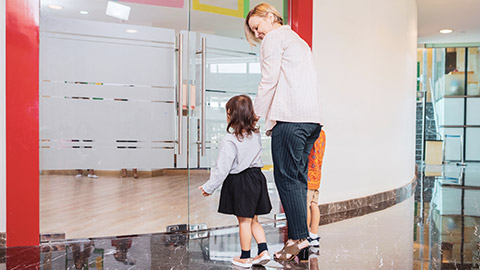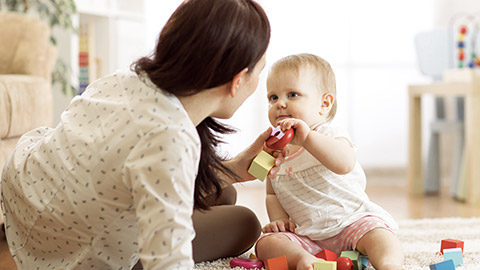Establishing and maintaining relationships with families is a fundamental aspect of early childhood education and care. These relationships form the backbone of a supportive and collaborative environment where children can thrive. By fostering strong connections with families, educators create a partnership based on trust, respect, and mutual understanding.
This partnership is essential for aligning the goals of the family and the educational setting, ensuring that each child's needs are met holistically. Building these relationships involves consistent communication, cultural sensitivity, and a commitment to working together, making it a cornerstone of effective early childhood practice.
Building and maintaining trusting relationships
Building and maintaining trusting relationships with families is a cornerstone of effective early childhood education. Trust forms the foundation for strong partnerships between educators and families, which are essential for supporting children’s development and well-being.
Trust is built through consistent, open, and honest communication. From the first interaction, educators should aim to establish a welcoming and supportive environment where families feel valued and respected. This involves being approachable, listening actively to family concerns, and responding promptly to their needs. Trust is also fostered by being transparent about the child’s progress and any challenges they may face, ensuring that families are fully informed and involved in their child’s learning journey.
Educators must be culturally competent and understand the values, beliefs, and practices that are important to each family. This may involve adapting communication styles, being sensitive to cultural norms, and demonstrating a genuine interest in learning about the family’s background. By respecting and celebrating diversity, educators create an inclusive environment where all families feel accepted and supported.
Trust is not just built; it must be maintained through regular and meaningful communication. This can include daily check-ins, scheduled meetings, or even informal chats during pick-up and drop-off times. Keeping families informed about their child’s activities, achievements, and any issues that arise helps sustain the trust that has been established. Additionally, using various communication methods—such as newsletters, emails, and digital platforms—ensures that all families are kept in the loop, regardless of their preferred way of staying connected.
Building and maintaining trusting relationships with families requires ongoing effort, cultural sensitivity, and a commitment to open and respectful communication. These relationships are essential for creating a positive and supportive environment where children can thrive.
Throughout this topic, we will discuss all these components and how they work together to create and maintain a trusting relationship between educators and families.
Strong partnerships with families are built on trust, respect, and a shared commitment to the well-being and development of the child— National Association for the Education of Young Children.(NAEYC)
Families come in all different shapes and sizes. Each family has a unique culture, background, values, and belief system. As an educator, you must understand and accept all families to create a sense of collaboration and belonging. Educators will engage with many families and must adjust their approach to ensure their relationship with each family is responsive, trustworthy, and professional, with the child's best interest in mind.
The Evolution of Families
The evolution of families has been a dynamic process influenced by cultural, economic, social, and technological changes throughout history.
Traditionally, Early Childhood Education primarily catered to the needs of nuclear families, where one parent, typically the mother, stayed home with the children. However, with the rise of dual-income households, single-parent families, blended families, and same-sex parent families, the expectations and needs of families have become more varied. This diversity requires educators to be flexible, inclusive, and culturally competent in their approach to working with children and their families.
The statistics provided on family types in Australia can be found in the following:
- Australian Bureau of Statistics (ABS): The ABS regularly publishes data on family structures through its Census and other surveys. The most recent Census data provides detailed insights into family types and compositions.
- Australian Institute of Family Studies (AIFS): The AIFS researches family dynamics and publishes reports that offer statistics and analyses on various family types.
- Australian Government Department of Social Services: This department provides reports and statistics on family structures, including data on single-parent families, same-sex families, and other family types.
Here are some current statistics on family types in Australia:
|
Nuclear Families  |
Around 70% of families in Australia are nuclear families, which consist of two parents and their children. This is the most common family structure, reflecting the traditional family unit model with both parents living with their children. |
|
Single-Parent Families  |
Approximately 15% of families are single-parent families. Single-parent families are typically headed by one parent who is responsible for raising the children. This category includes both single mothers and single fathers. |
|
Blended Families  |
About 8% of families are blended families, which involve one or both partners having children from previous relationships. |
|
Same-Sex Families  |
Around 2% of families are same-sex couples, either with children or without. |
|
Extended Families  |
Approximately 5% of families are extended families, where relatives such as grandparents, aunts, uncles, or cousins live together or in close proximity. Extended families often include additional family members beyond the nuclear family unit, providing additional support and shared responsibilities. |
Data tracked over time indicates that family and household structures are changing. Notable points include:
- It is less common in Australia than in other countries for children to live with their parents and grandparents
- Our population is aging, with many older couples or single-person households
- Extended families (living together in one household) are smaller than they were in the past
- First Nations families are occupying more households today than in the past
- Many families have immigrated to live in Australia.
According to the Australian Institute of Family Studies (AIFS), the change in dynamics from the traditional nuclear family in the early 20th century to other family structures is due to:
- equality of same-gender parents
- lower fertility rate
- economic impacts
- marriage rates are down
- divorce rates are up, creating single or blended families
- changes to religious stances
- social acceptance of non-children families and diverse family structures
- poverty and socio-economic/cultural impacts.
The following graph from the AIFS2 demonstrates that our population in Australia is diverse and includes people born all over the world. The majority (over 60%) of people living in households in Australia were born in Australia, dropping from over 70% in the 1980s.
The number of people born in Asia and New Zealand living in Australia has increased, and the number of people born in Ireland, Europe and the UK has dropped.
Reading
Additional information about families can be found in the following facts and figures articles provided on the Australian Institute of Family Studies website: Facts and Figures.
Family Structure

Family structure refers to the composition and organisation of a family, including the relationships between family members and the roles they play within the household. It encompasses the various types of families that exist in society, each with its unique characteristics and dynamics.
It is interesting to look at the families living in Australia and how they have evolved. Data from the AIFS3 shows that couples with dependent children have decreased significantly, where only 36.8% of families in 2016 lived in a family unit as a couple with dependent children, whilst single-parent families have increased to 10.7% in 2006 but reduced slightly in 2016.
The following table outlines some typical family types and their characteristics.
| Family Types | Characteristics |
|---|---|
| The nuclear family (also known as a couple family) | Parents (mother and father) and their biological children live in the same home. |
| Single-parent family or custody arrangements such as shared custody | Parents who are separated, parents who have born a child through IVF alone, parents who cannot see their child due to custody order or have arrangements in place such as specific days they take care of the child(ren). |
| Same-sex parents with children | Parents who are of the same sex or transgender families living with children. One parent might be the birth parent, or they may have adopted. |
| Non-related guardianship, such as adoption/foster care | Children who have been adopted, possibly from a different background, children in care with family members due to foster care arrangement, and children with foster care families (within the foster care system) who are not related to them. Some children might be brought to the service by the government, known as the Guardian of the Minister. |
| Blended families or families with stepparents | Families who have separated and have reformed families with other families or with stepparents and stepchildren. They may also have more biological children together. |
| Grandparents as guardians | Children who live with their grandparents on a permanent or semi-permanent basis. Grandparents who are the guardians of the child(ren). |
Reading
Many useful resources can be found on the Raising Children Network website to help you understand the parent's perspective around family diversity: Grown-Ups: Family Diversity.
Understanding the Main Approaches to Child Rearing
Each parent and family has an individual style and approach. Their family dynamic and practice can be influenced by so many things, including:
- cultural background
- life circumstances/situation
- family dynamics/size/structure
- parenting styles/modes
- access to support and information
- own childhood
- socioeconomic status
Raising children is unique for different families, cultures, and life circumstances. Many child-rearing practices have emerged and been shared. With easy access to the internet, parents follow a variety of parenting styles and approaches.
Along with family structure, as an educator, you also need to consider each family's culture and lifestyle. Each family is diverse. The level of diversity and similarities among families will differ frequently. You will need to consider how you relate and engage with the family. You may want to consider the language you use—both verbal and body language, and the time you might need to set aside to support the family and their parenting style and beliefs. You should consider your thoughts and reactions to each family and ensure you are not making assumptions. For example, saying 'mum and dad' will not capture all children, as the children you care for may have different family structures.
There is no one right way to raise a child or one ideal family situation. Parents have different beliefs about what is best for their children, which are reflected in the diverse range of child-rearing practices and parenting styles. The educator needs to understand their personal experiences of being raised or raising their own family and the influence this may have on their beliefs about parenting.
Educators may believe that the best way to parent is to be open-minded and flexible or to be strict, set boundaries, and teach manners and respect. However, it is important to consider each family situation individually, not be judgemental or biased to their own beliefs, and allow the family to make decisions about their parenting based on what will work best for their child.
| Child-Rearing Practice | Features and Characteristics | Impact on Children |
|---|---|---|
|
Authoritative Parenting |
Balances high responsiveness with high demands. Parents set clear rules and expectations while being supportive and nurturing. Encourages independence, provides guidance, and involves open communication. |
This often leads to children who are responsible, self-regulated, and have high self-esteem. |
| Authoritarian Parenting |
Emphasises obedience and discipline, with strict rules and expectations. Parents are less responsive to the child's needs. High demands with low responsiveness, less focus on open dialogue, and emphasis on obedience. |
This may lead to children who are obedient but could struggle with self-esteem and social competence. |
|
Permissive Parenting |
Highly responsive and nurturing but with few rules and demands. Parents act more like friends than authority figures. Lenient and indulgent allows the child significant freedom. |
This can lead to children who are impulsive, with potential difficulties in self-discipline and authority respect. |
| Uninvolved Parenting | Characterised by low responsiveness and low demands. Parents provide little guidance, support, or attention to the child. Neglectful, indifferent, minimal interaction with the child. |
This often leads to children who may struggle with self-esteem, social skills, and academic performance due to a lack of guidance and emotional support. |
Watch
Watch the YouTube video from Daniel Storage to learn more about various parenting styles and how they affect children: Parenting Styles and Their Effects on Children.
Child rearing and parenting can significantly impact how someone develops as a child and who they become as an adult. Parenting forms a basis for a person's perspectives of the world, for their opinions and influences their choices.
Explore
Review this article from Zero to Three about how the past impacts of your childhood experiences can influence how you parent.
Reflection
Reflect on your personal experiences with parenting and how these experiences have shaped your approach to teaching, your professional practices, and your overall worldview.
Consider how your own parenting journey influences your interactions with children, your educational strategies, and your perspective on child development and family dynamics.
Supporting families in their parenting styles
Educators in early childhood settings often encounter diverse parenting styles, each influenced by the family's unique cultural, social, and personal values. Understanding and respecting these differences is crucial for building strong partnerships with families. By working collaboratively with parents, educators can create an environment that supports the child’s development while honouring the families' approach to parenting. This requires flexibility, open communication, and a commitment to understanding the family's perspective, allowing educators to effectively support and complement the parenting styles of the families they work with.
As educators, it's essential for us to understand and support families in their parenting styles and choices while fulfilling our responsibilities. When a family's practices do not align with the safety standards outlined by our National Quality Framework, it's important to sensitively engage the parents in shared decision-making regarding their child's care.
Examples of parenting practices that may challenge the service's health and safety considerations might include:
| Wearing Amber Necklaces | Parents might request that their child wears an amber necklace to bed, believing it has health benefits despite potential choking hazards or allergies associated with such items. |
|---|---|
| Constant Wearing of Religious Jewellery | Parents may want their child to wear a necklace or other jewellery at all times for religious reasons, which could pose safety risks or interfere with the child's daily activities. |
| Continuous Carrying and Holding | Some parents may request that their child be carried and held throughout the day, which might conflict with the service’s policies on promoting independence and mobility. |
| Non-Compliance with Dietary Requirements | Parents might if you can provide their child with alternative food that does not meet the service’s national dietary guidelines, potentially impacting their health and nutrition. |
| Skipping Naps: | Parents may request that their child’s naps be skipped, even though sleep recommendations suggest specific nap times for the child’s age group to support their overall development and well-being. |
The following strategies can help Early Childhood Educators support families in their parenting styles:
With these strategies, educators can effectively support families in their parenting styles, fostering a collaborative environment that benefits the child’s overall development.
Practice
Sleep Requirements

This morning, Tina's mum, Sandy, dropped her off and requested that Tina skip her nap today. Sandy mentioned that Tina hasn't been sleeping well at night, so she wants to hold off on daytime sleep to help her rest better during the night.
Tina is 4.5 months old and usually sleeps twice during the day. As an educator, it is important to consider both the child's needs and the parent's requests. Researching and basing decisions on advice from recognised health authorities can support decision-making and communication with the family.
Research and identify the sleep requirements for Tina's age. Describe how you would handle this situation and communicate with Sandy regarding Tina's sleep.
Ensure that you keep notes for future reference, as this information will support your assessment and professional practice.
Providing personalised care for each family's needs
Every family and child is unique, bringing their own set of values, beliefs, culture, and family history that shape their identity and influence their care needs. Recognising the significance of these elements is a crucial responsibility for educators and is an integral part of building meaningful relationships with families.
Asking parents questions about key aspects of their background and practices can help you implement strategies that will help the child feel a sense of belonging and ensure smooth transitions between home and care.
When seeking to understand a child's background and tailor care to their needs, consider gathering information on the following aspects:
- Spirituality: Explore any spiritual or religious practices that are important to the family. This might include specific rituals, holidays, or values that play a role in the child's life and can influence their needs and behaviour in a care setting.
- Values and Beliefs: Understand the core values and beliefs guiding the family’s parenting and child-rearing approach. This includes their views on discipline, education, health, and other aspects of child development.
- Culture: Learn about the family’s cultural background, including traditions, customs, languages spoken, and cultural norms. This helps ensure that the child’s cultural identity is respected and incorporated into their care routine.
- Family History: Gather information about the family’s history, such as significant events, family dynamics, or past experiences that might impact the child’s needs or behaviour. This background can provide insight into the child’s emotional and psychological context.
- Lifestyle: Understand the family’s lifestyle, including daily routines, work schedules, and activities. This information helps to align the care routine with the child’s home environment and supports a smoother transition between home and the care setting.
- Experiences: Consider any relevant experiences the child or family has had that may affect their current situation, such as previous childcare arrangements, health issues, or significant life changes. This context helps in addressing any specific needs or challenges the child may face.
- Care Routine: Inquire about the family’s existing care routine, including sleep patterns, feeding practices, and daily schedules. This ensures continuity between home and the care setting, helping the child feel secure and supported.
By seeking detailed information in these areas, educators can better understand and meet each child's and their family's diverse needs, fostering a supportive and inclusive environment.
Examples of how these key aspects can contribute to your planning and care for the child include:
| Category | Information From Family | Planning for Education and Care of this Child |
|---|---|---|
| Family History | The parents divorced last year, and the children have been moving between the care of their parents and grandparents. It has been unsettled. | Consistency of care for the child and stories about living with mum, dad and grandparents. |
| Experiences | Travelled to several countries and lived overseas in Africa for six months. | Supporting the child in sharing their experiences, bringing in photos, and talking about their experiences. Have worldly resources for the child to play with. |
| Beliefs | Seventh Day Adventist |
Check with the parents before celebrating events such as Christmas and Easter. Ask questions about their beliefs. |
Pedagogy
In Early Childhood Education and Care (ECEC), pedagogy refers to the methods and practices used by educators to facilitate children's learning and development. It encompasses the strategies, approaches, and principles that guide how educators interact with children, plan activities, and create learning environments. Pedagogy in ECEC is focused on fostering children's growth, supporting their individual needs, and promoting their overall well-being through responsive and effective teaching practices.
Practice
Pedagogy
Imagine you're caring for a child from a cultural background where it is customary for them to be held frequently. Without knowledge of this cultural practice, you might find it challenging to understand why the child clings to you and has difficulty settling without being held.
Understanding this cultural context allows you to tailor your strategies to support the child in gradually gaining confidence to explore independently while respecting their cultural needs.
Identify three strategies you could use to support the child in aligning with their parents' parenting style, ensuring a respectful and effective approach.
Remember to document these strategies for future reference, as this will aid in your assessment and professional development.
Watch
Watch the following YouTube video from Early Childhood Videos to understand more about the importance of awareness of culture.
Explore
Childhood Experiences
Identify at least three aspects of your pedagogy that have been shaped by your childhood experiences. Reflect on how these experiences might enhance your ability to be accepting and understanding of the families you work with.
Make sure to document these insights for future reference, as they will be valuable for your assessment and professional development.

Belonging is as important for family members as it is for the children in our care.EYLF Framework
Parents are the fundamental nurturers and supporters of their child's development, establishing a profound and unique bond that is central to the child’s growth. They possess the most intimate understanding of their family’s cultural practices, values, and traditions, which shape how they care for and raise their child. Although children might spend a limited time, typically up to four years, in an Early Learning Setting, their family's presence will remain constant throughout their lives.
Recognising and respecting the bond between families and their children is essential for providing effective support in early childhood education. Families are the child’s first and most significant caregivers, forming a foundational relationship that shapes the child’s emotional and developmental growth. This bond, established from birth and reinforced through daily interactions, conversation, and physical nurturing, is crucial for the child’s overall development and brain growth.
An Educator's role is to collaborate with and support families throughout their child’s developmental journey. This involves respecting and integrating the family's cultural background and parenting approaches into our care practices. By doing so, they acknowledge the critical role families play in their child’s life and work together to enhance the child's overall development and well-being. Engaging with families in a supportive partnership ensures that educational strategies and care routines are aligned with the child’s needs and family values, creating a cohesive and nurturing environment for the child.
Watch
Family influence
The family significantly impacts a child’s holistic development. They play a crucial role in shaping the child's overall growth and identity before they enter your care. Collaborating with these knowledgeable family members is essential for effectively addressing the child's well-being and meeting their needs.
Understanding the whole child is understanding all the elements involved in making them. This includes:
- family structures
- type of home and neighbourhood they live in
- the family's social life
- social acceptance and activities
- the child’s independent developmental skills, educational or childcare experiences, and engagement with the community.
It also includes economic factors, genes, gender, personality, language spoken, religion, friendships, culture and child-rearing practices.
Impact on Holistic Development
The role of the family in a child’s holistic development is profound and multifaceted. Here’s an elaboration on how families influence various aspects of a child's growth and how collaboration with families can enhance their development in early childhood settings:
Emotional and Social Development
- Attachment and Bonding: Families are the primary source of emotional support and attachment from birth. The quality of this early bond significantly impacts a child’s emotional security and social interactions. Children learn to navigate relationships, express emotions, and develop empathy based on their experiences within the family.
- Social Skills: Family dynamics and interactions shape a child’s social behaviour. For instance, how parents model communication, conflict resolution, and cooperation influences how children interact with peers and adults.
Cognitive and Language Development
- Early Learning Environment: Families are the first educators to provide foundational learning experiences through everyday interactions, storytelling, and play. These early experiences support cognitive development, language acquisition, and problem-solving skills.
- Cultural Influences: The family’s cultural background affects the child’s worldview and cognitive processes. Exposure to different languages, traditions, and problem-solving approaches enriches a child’s cognitive development.
Physical Development
- Health and Nutrition: Families are responsible for providing the nutrition and physical care that support a child’s growth. Nutritional choices, activity levels, and healthcare routines established at home directly affect physical development.
- Daily Routines: Family practices regarding sleep, hygiene, and physical activity contribute to a child’s overall health and well-being. Consistent routines help establish a foundation for healthy physical development.
Moral and Values Formation
- Value Systems: Families instil moral values and ethical beliefs that guide a child’s behaviour and decision-making. These values shape how children perceive right and wrong and how they interact with others in a social setting.
- Cultural and Religious Beliefs: Cultural and religious practices introduced by the family influence a child’s understanding of identity, community, and traditions. These aspects contribute to the child's sense of belonging and cultural awareness.
Importance of collaborating with families
Good collaboration means keeping open lines of communication, showing respect, and working towards common goals. It helps ensure that the care and teaching provided in the early childhood setting match what happens at home, making transitions smoother for the child. This partnership also supports families by giving them tools and strategies to help their child’s development both at home and in the classroom.
Understanding the Child’s Background
Families provide detailed knowledge about their child’s history, preferences, and needs. This understanding is crucial for educators to tailor their approaches and create an environment that aligns with the child’s existing experiences and developmental needs. By working closely with families, educators can better address specific challenges or requirements that a child may have, ensuring that interventions and support strategies are effective and relevant.
Creating a Supportive Environment
Collaborating with families helps ensure that there is consistency between the child’s home environment and the early childhood setting. This alignment supports smoother transitions and reinforces learning and behavioural expectations.
When working together, educators and families can set shared goals for the child’s development. This collaborative approach fosters a unified strategy to support the child’s growth and address any concerns.
Enhancing Family Engagement
Positive collaboration with families builds strong relationships and trust. When families feel valued and involved, they are more likely to engage actively in their child’s education and development.
Educators can provide families with resources, strategies, and support to enhance their parenting practices. This empowerment helps families contribute more effectively to their child’s development and well-being.
Addressing Diverse Needs
Understanding and respecting the family’s cultural background allows educators to create an inclusive environment honouring the child’s heritage and supporting their cultural identity.
Collaboration ensures that educators can adapt their practices to meet the unique needs of each child, whether related to developmental milestones, cultural practices, or individual preferences.
The early childhood setting matches what happens at home, making transitions smoother for the child. This partnership also supports families by giving them tools and strategies to help their child’s development both at home and in the classroom.
The family’s influence on a child’s holistic development is significant and forms the basis for many aspects of their growth. By acknowledging the critical role of families and fostering a collaborative relationship, educators can create a more supportive and responsive learning environment. This partnership enhances the child’s well-being and development and strengthens the connection between home and early childhood settings, ultimately benefiting the child’s overall educational experience.
Watch
Watch the following YouTube video from ECETP to learn more about the crucial role of primary caregivers.
Reading
Read the following article from Goodwin University on the role of parents in the Reggio Emilia approach to education: The Role of Parents in a Reggio Emilia Education.
Theories and research that underpin the value of family relationships with educators
Understanding the dynamics of family relationships in early childhood education is crucial for fostering a supportive and effective learning environment. Theoretical frameworks provide valuable insights into how these relationships impact a child's development and learning. Three significant theories that explore these dynamics are
- Bronfenbrenner's Ecological Systems Theory
- Vygotsky’s Sociocultural Theory
- Epstein's Framework of Six Types of Parental Involvement.
Each theory offers a unique perspective on the role of family and educator interactions in a child's growth and educational experience. By examining these theories, we can better appreciate how strong, positive relationships between families and educators contribute to a child’s overall well-being and academic success.
|
Bronfenbrenner's Ecological Systems Theory
 |
Urie Bronfenbrenner's Ecological Systems Theory posits that a child’s development is influenced by different environmental systems, with the microsystem being the closest to the child. This includes family and educators who interact directly with the child. The theory emphasises that the child’s immediate environment (family and educators) plays a crucial role in their development. Strong, positive relationships between families and educators create a cohesive support system around the child, promoting their overall well-being and development. Studies based on this theory show that when families and educators collaborate, children experience consistent support across home and school environments, leading to better social, emotional, and academic outcomes. |
|
Lev Vygotsky’s Sociocultural Theory
 |
Lev Vygotsky’s Sociocultural Theory highlights the importance of social interaction in learning and development. It suggests that children learn through interactions with more knowledgeable others, including family members and educators. The theory underscores the value of communication and collaboration between families and educators. By working together, they create enriched learning experiences that reflect the child’s cultural background, enhancing the child’s learning and development. Research rooted in Vygotsky’s theory demonstrates that when educators engage with families and incorporate their cultural and social contexts into the learning environment, children show improved cognitive and language development. |
|
Joyce Epstein’s Framework
 |
Joyce Epstein’s Framework outlines six types of involvement that connect families, schools, and communities: parenting, communicating, volunteering, learning at home, decision-making, and collaborating with the community. This framework emphasises the need for schools to engage families in various aspects of their children’s education. Strong relationships between families and educators foster parental involvement in school activities, decision-making, and at-home learning, which contributes to better educational outcomes for children. Research associated with Epstein’s framework has shown that schools with active family engagement programs see higher levels of student achievement, better attendance, and more positive attitudes toward school from both children and parents. |
Watch
Here are YouTube video links that provide explanations and overviews of each of the three theories:
Bronfenbrenner's Ecological Systems Theory
Vygotsky’s Sociocultural Theory
These videos should provide a good overview of each theory and help you understand their relevance to early childhood education.
National Quality Area 6 - Collaborative Partnerships with Families and Communities

The National Quality Standard (NQS) ensures that early childhood services provide high-quality education and care. It encompasses seven quality areas:
- Educational Program and Practice
- Children’s Health and Safety
- Physical Environment
- Staffing Arrangements
- Relationships with Children
- Collaborative Partnerships with Families and Communities
- Governance and Leadership
For this topic, Quality Area 6 is particularly relevant. It focuses on Collaborative Partnerships with Families and Communities, which emphasises the importance of building and maintaining strong relationships with families, working together to support the child’s development, and engaging with the community. This area highlights the role of educators in fostering meaningful partnerships with families and leveraging community resources to enhance the educational experience for children.
Quality Area 6 under the National Quality Standard recognises that collaborative relationships with families are fundamental to achieving quality outcomes for children. Ensuring community partnership based on active communication, consultation, and collaboration is also essential.
Collaborative Partnerships With Families and Communities
Quality Area 6 of the NQS has two standards and six elements, all related to relationships with families and communities. This quality area aims for services to form and maintain partnerships with families and communities to enhance children's learning, development and well-being.
See each standard and element in the following table:
| Standard 6.1 | Supportive relationships with families | Respectful relationships with families are developed and maintained, and families are supported in their parenting role. |
|---|---|---|
| Element 6.1.1 | Engagement with the service | Families are supported from enrolment to be involved in the service and contribute to service decisions. |
| Element 6.1.2 | Parent views are respected |
Parent views are respected The expertise, culture, values, and beliefs of families are respected, and families share in decision-making about their children's learning and wellbeing. |
| Element 6.1.3 | Families are supported | Current information is available to families about the service and relevant community services and resources to support parenting and family wellbeing. |
| Standard 6.2 | Collaborative partnerships | Collaborative partnerships enhance children's inclusion, learning and wellbeing. |
| Standard 6.2.1 | Transitions | Continuity of learning and transitions for each child is supported by sharing information and clarifying responsibilities. |
| Standard 6.2.2 | Access and participation | Effective partnerships support children's access, inclusion, and participation in the program. |
| Standard 6.2.3 | Community engagement | The service builds relationships and engages with its community. |
Watch
Importance of Quality Area 6 in the NQS
Quality Area 6 of the National Quality Standard (NQS) focuses on "Collaborative Partnerships with Families and Communities." This area emphasises the importance of building strong, respectful, and collaborative relationships between early childhood services, families, and the wider community.
Key reasons why Quality Area 6 is important:
- Enhanced Child Development: By working closely with families and communities, educators can gain a deeper understanding of each child’s background, culture, and needs. This collaboration ensures that the care and education provided are tailored to support the child's overall development.
- Supporting Family Involvement: Quality Area 6 encourages active family participation in their child’s learning and development. When families are involved, they can share valuable insights and feedback, which helps educators create more meaningful and relevant learning experiences for the child.
- Building Trusting Relationships: Strong partnerships between educators and families build trust, which is essential for a positive and supportive environment. Trusting relationships enable open communication, which is vital for addressing concerns, sharing successes, and working together to support the child's well-being.
- Community Engagement: Quality Area 6 also highlights the importance of connecting with the broader community. By engaging with local resources, services, and cultural groups, early childhood settings can enrich their programs and provide children with diverse experiences that reflect their community.
- Improving Outcomes for Children: When families, educators, and communities collaborate effectively, the outcomes for children improve. This teamwork ensures that children receive consistent support across different environments, promoting their learning, development, and well-being.
Overall, Quality Area 6 is fundamental to creating a supportive, inclusive, and effective early childhood setting where children can thrive and families feel valued as active partners in their child's education.
Reading
To explore how Quality Area 6 of the National Quality Standard (NQS) fosters collaboration between families and educators, click here to access detailed information about each of the standards/elements.
This will highlight how Quality Area 6 contributes to quality education and care through the importance of building strong partnerships that enhance children’s learning experiences and promote their overall well-being.
Code of Ethics
The Code of Ethics in early childhood education serves as a foundational guide for educators, helping them navigate the complexities of their professional responsibilities. It provides a clear set of ethical principles that ensure educators uphold the highest standards in their interactions with children, families, colleagues, and the broader community.
Why the Code of Ethics is Important:
Guidance for Professional Conduct: The Code of Ethics outlines the values and behaviours expected of early childhood educators. It guides them in making informed, ethical decisions in their day-to-day practice, ensuring they act with integrity, respect, and fairness.
- Promoting the Well-being of Children: It is a commitment to prioritising children's well-being, development, and learning. It emphasises the importance of creating a safe, nurturing, and inclusive environment where all children can thrive.
- Strengthening Relationships with Families: highlights the importance of building trusting, respectful partnerships with families. By working collaboratively with families, educators can better understand and meet the unique needs of each child, fostering a supportive and cohesive community.
- Supporting Reflective Practice: encourages educators to engage in reflective practice, continuously evaluating and improving their approaches to teaching and caregiving.
- Enhancing Professionalism: It helps educators maintain a sense of accountability and pride in their work, reinforcing the importance of ethical standards in providing high-quality care and education.
- Navigating Ethical Dilemmas: The Code provides a framework for resolving ethical dilemmas that may arise in practice. Whether dealing with conflicts of interest, issues of confidentiality, or cultural sensitivities, the Code offers a consistent and principled approach to ethical decision-making.
The Code of Ethics is vital in ensuring that early childhood education is grounded in ethical principles that prioritise the well-being of children and foster a respectful, inclusive, and professional environment for all stakeholders involved.
The Early Childhood Australia (ECA) Code of Ethics is on their website. Here is the direct link to the document: ECA Code of Ethics. This document provides the ethical principles that guide the professional conduct of early childhood educators in Australia.
The following case study presents an example of an ethical dilemma that can occur in an Early Learning Service involving educators and families.
Case Study

At a daycare centre, Ms Green, an educator, is responsible for caring for a young child, Ella, who is 18 months old. Ella’s mother, Mrs Johnson, has recently requested that Ella be weaned off her dummy because Mrs Johnson believes it is affecting Ella's speech development and wants her to stop using it by the end of the month.
Ella, however, is very attached to her pacifier and becomes distressed and inconsolable when it is taken away. Ms Green is concerned about Ella's emotional well-being, as she cries extensively and appears quite upset when the pacifier is unavailable. She also understands the importance of respecting parental wishes and following their instructions.
Should Ms. Green:
- Follow the Parent’s Request: Strictly adhere to Mrs Johnson’s request and attempt to wean Ella off the pacifier as soon as possible, even though this might cause significant distress to Ella.
- Prioritise the Child’s Comfort: Continue allowing Ella to use the pacifier as needed to ensure she is comfortable and not excessively upset, potentially delaying the weaning process and discussing the situation further with Mrs. Johnson to find a compromise.
Considerations:
- Child’s Emotional Well-Being: Ella’s comfort and emotional well-being are important. Excessive distress might affect her overall mood and behaviour, which could impact her experience at the daycare.
- Parental Wishes: Mrs Johnson has expressed a clear preference for Ella to stop using the dummy. Respecting parental wishes is key to working with families, but it should be balanced with the child’s needs.
- Developmental Appropriateness: Consider whether the weaning process is developmentally appropriate for Ella. For many children, gradual weaning might be more effective and less distressing.
- Communication: Open and empathetic communication with Mrs. Johnson is crucial. Discussing Ella’s reaction to the weaning process might help find a solution that addresses both her comfort and Mrs. Johnson’s concerns.
Possible Actions:
- Gradual Weaning: Propose a gradual weaning plan for Mrs Johnson, where the pacifier is phased out slowly to minimise Ella’s distress. This could involve limiting pacifier use to specific times or gradually reducing its availability.
- Document Reactions: Keep a record of Ella’s reactions and behaviour when the pacifier is not available, and share this information with Mrs Johnson to provide context for why a gradual approach might be beneficial.
- Collaborate with Parents: Work with Mrs. Johnson to develop a plan that respects her wishes but also considers Ella’s emotional needs. This might involve a timeline and specific strategies to support Ella through the transition.
- Provide Support: Offer comfort and alternative soothing strategies to Ella during the weaning process, such as providing additional comfort objects or engaging in calming activities to help her adjust.
In light of the situation where Ella’s mother has requested that she be weaned off her pacifier, but Ella becomes very distressed without it, how should Ms. Green approach this dilemma? What steps should she take to balance respecting the parent's wishes with addressing Ella’s immediate emotional needs?
Practice
Developing Positive Relationships with Families
Read the article by Elena Aguilar from Edutopia: 20 Tips for Developing Positive Relationships With Parents.
Choose one tip for developing positive relationships with parents and discuss why this is important.
Ensure that you keep notes for future reference, as this information will support your assessment and professional practice.

Establishing strong relationships with families is a cornerstone of effective Early Childhood Education. These connections create a foundation of trust and open communication, allowing educators to understand each child’s unique background, needs, and strengths better. By building positive relationships with families, educators can work collaboratively to support the child’s development, create a cohesive learning environment, and ensure that the child’s experience is enriched by the shared insights and expertise of both the family and the educator.
As with any relationships-based sector/profession, educators need to develop skills for engaging professionally with a diverse range of people. Building positive relationships with families requires effective communication skills.
Educators will build positive relationships by:
- being available and encouraging communication opportunities
- interact with families in an open, helpful and encouraging manner
- express genuine concern for the children
- provide opportunities for families to raise concerns or questions and work with them to resolve them.
Once this communication pattern is established, parents will be confident to approach staff and share information. This will assist in building an ongoing positive relationship.
When parents and educators communicate effectively, they may identify areas the child can develop and support in the home and the service. Sometimes, shared information will identify social challenges for a child, such as being quiet in care but outgoing at home.
There are many ways to communicate with families of children and other people who are important partners in their care, such as psychologists, speech pathologists, and occupational therapists. These communication techniques include:
Developing skills in the above communication modalities is important to enhance your relationship and partnership with families.
When communicating with families, ensure that communication is accessible for all family members. The format must be accessible and easy for families to understand. Information should be available in various languages for families that speak languages other than English.
Accessible information
Ensure that all information provided online is also available and accessible in other formats where necessary if a family does not have access to the internet. Some services offer families free WiFi and computer access to support them with tasks such as Centrelink and CCS sign-up.
When communicating with families, the communication style must be clear and reflect the professional nature of the relationship. Communication skills can be enhanced through a focus on these skills and practice.
Communication Techniques
Effective communication is fundamental in building strong, supportive relationships, especially in the context of early childhood education. For educators, mastering communication techniques is crucial to engaging with families, understanding their needs, and collaborating effectively to support each child's development.
Communication techniques encompass a variety of methods and strategies that help ensure messages are conveyed clearly, understood accurately, and received positively. These techniques include both verbal and non-verbal approaches, each playing a role in fostering a productive and respectful dialogue.
Key communication techniques include:
| Communication Technique | What Does This Look Like? |
|---|---|
| Active Listening | Make eye contact (where culturally relevant) and pay attention Observe body language, tone, and expressions Summarise, clarify, and ask open-ended questions Ask probing questions where relevant and paraphrase. Do not interrupt; be attuned to and respect the feelings of others. |
| Building Rapport with families and children | Be attentive and positive Be approachable and professional Use mutually comprehensive language and communication Practice active listening skills Use positive body language Be empathetic Find common ground and create shared experiences Mirror and match mannerisms where appropriate professionally Be culturally appropriate Remember a person's name Call the child by name and remember key details to show your genuine interest. Come down to the child's level, make eye contact and remain attentive to their story during the interaction. |
| Collaborative Discussion and Decision-Making | Arrange appropriate times to meet Listen and question Be open-minded Ask for perspectives and be open to negotiations |
| Provision of Clear Verbal Information | Ensure all information you provide is current, appropriate, and accurate Speak clearly and use a language or information format relevant to them and their needs Use appropriate language, not industry jargon, where inappropriate Communicate information to families promptly, relevant to the urgency of the information and in a time stated by yourself, the service or the policy statement |
| Questioning | Consider if the question is relevant and professional Explain what the question is supporting in practice, e.g. to inform the program Consider if you are the right person to ask or answer questions; if not, delegate to the right provider Create an open relationship with the family so that they feel they can ask you questions in return Consider the delivery and location of the questioning Ensure privacy and confidentiality are upheld where relevant |
| Negotiation | Create a mutually respectful conversation Ask questions and use active listening Discuss several options in the negotiation Consider limits: service policies, United Nations Rights of the Child, the Code of Ethics, national legislation and regulations, etc. Allow parents to make suggestions first. Share knowledge and expertise where relevant, especially concerning limits Offer to do further research where a negotiation has not been finalised Try to come to a solution, but if none can be found, make another date to discuss further Stay positive and respectful at all times Remember that this is the family of the child and the first educator |
| Responding to Questions and Concerns | Acknowledge questions and respond with answers Be clear with responses Ask further questions Read body language and tone of voice to ensure concerns are addressed Talk about concerns and acknowledge issues |
Another effective communication technique involves using both open-ended and closed questions to gather information and confirm understanding. Each type of question serves a specific purpose and can help facilitate clearer and more productive conversations.
Open-ended questions encourage detailed responses and promote discussion. These questions often begin with "what," "how," or "explain," and they allow the respondent to share more comprehensive information and insights. For example:
- "What specific goals do you have for your child’s development?"
- "How can we better support your child’s learning needs?"
- "Can you explain any particular routines at home that we should be aware of?"
Open-ended questions are valuable for exploring thoughts, feelings, and experiences in depth, fostering a more collaborative dialogue and gaining a deeper understanding of the family’s perspective.
Closed questions, on the other hand, are designed to elicit concise, specific responses, often requiring a simple "yes" or "no" or a brief factual answer. These questions usually begin with "is," "will," "have," "should," "may," or "did." For example:
- "Is there any additional information you need from us?"
- "Will your child be participating in the upcoming event?"
- "Have you noticed any changes in your child's behaviour?"
Closed questions are useful for confirming details, making decisions, and ensuring clarity. They help verify specific information and guide the conversation towards concrete outcomes.
By combining these questioning techniques, educators can effectively gather detailed information, clarify understanding, and ensure that communication with families is thorough and productive.
Watch
Watch the YouTube video from Brainy Dose to improve your communication skills: 12 Ways to Improve Communication Skills Instantly.
Practice
Communication Skills
Identify and provide an example of a situation where you would use each communication technique and explain how you would use it.
- Active Listening
- Building Rapport with families and children
- Collaborative Discussion and Decision-Making
- Provision of Clear Verbal Information
- Questioning
- Negotiation
- Responding to Questions and Concerns
Ensure that you keep notes for future reference, as this information will support your assessment and professional practice.



